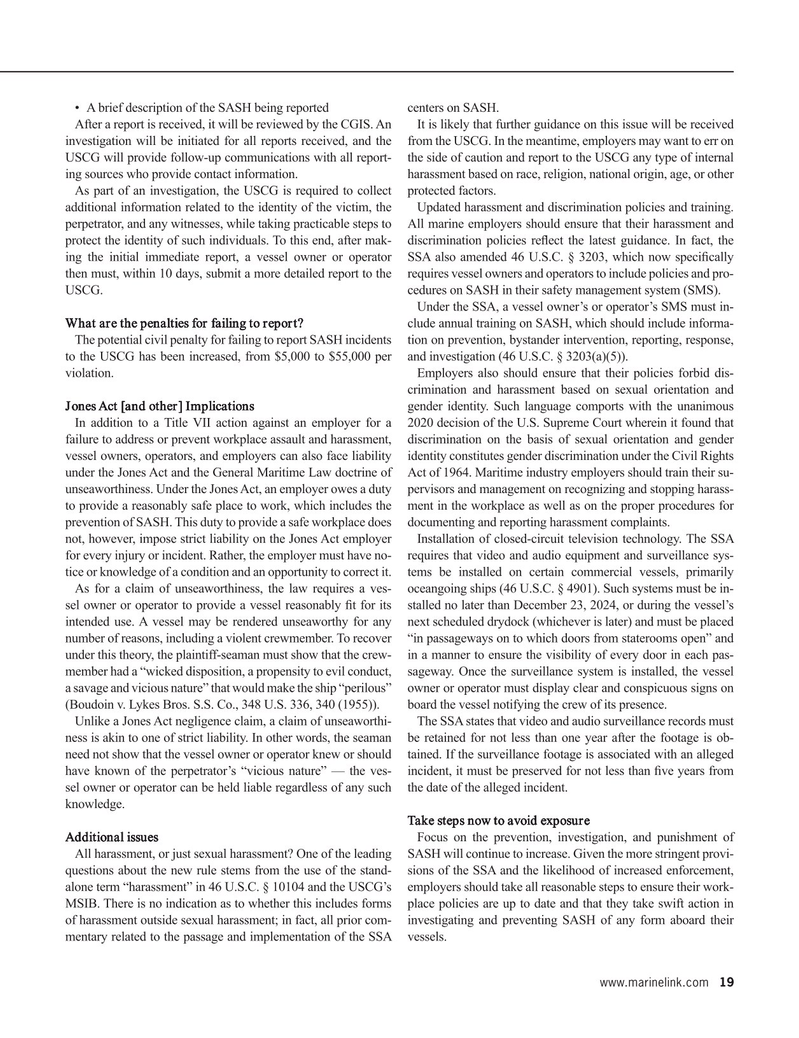
Page 19: of Maritime Reporter Magazine (September 2023)
Marine Design Edition
Read this page in Pdf, Flash or Html5 edition of September 2023 Maritime Reporter Magazine
• A brief description of the SASH being reported centers on SASH.
After a report is received, it will be reviewed by the CGIS. An It is likely that further guidance on this issue will be received investigation will be initiated for all reports received, and the from the USCG. In the meantime, employers may want to err on
USCG will provide follow-up communications with all report- the side of caution and report to the USCG any type of internal ing sources who provide contact information. harassment based on race, religion, national origin, age, or other
As part of an investigation, the USCG is required to collect protected factors.
additional information related to the identity of the victim, the Updated harassment and discrimination policies and training. perpetrator, and any witnesses, while taking practicable steps to All marine employers should ensure that their harassment and protect the identity of such individuals. To this end, after mak- discrimination policies re? ect the latest guidance. In fact, the ing the initial immediate report, a vessel owner or operator SSA also amended 46 U.S.C. § 3203, which now speci? cally then must, within 10 days, submit a more detailed report to the requires vessel owners and operators to include policies and pro-
USCG. cedures on SASH in their safety management system (SMS).
Under the SSA, a vessel owner’s or operator’s SMS must in-
What are the penalties for failing to report? clude annual training on SASH, which should include informa-
The potential civil penalty for failing to report SASH incidents tion on prevention, bystander intervention, reporting, response, to the USCG has been increased, from $5,000 to $55,000 per and investigation (46 U.S.C. § 3203(a)(5)).
violation. Employers also should ensure that their policies forbid dis- crimination and harassment based on sexual orientation and
Jones Act [and other] Implications gender identity. Such language comports with the unanimous
In addition to a Title VII action against an employer for a 2020 decision of the U.S. Supreme Court wherein it found that failure to address or prevent workplace assault and harassment, discrimination on the basis of sexual orientation and gender vessel owners, operators, and employers can also face liability identity constitutes gender discrimination under the Civil Rights under the Jones Act and the General Maritime Law doctrine of Act of 1964. Maritime industry employers should train their su- unseaworthiness. Under the Jones Act, an employer owes a duty pervisors and management on recognizing and stopping harass- to provide a reasonably safe place to work, which includes the ment in the workplace as well as on the proper procedures for prevention of SASH. This duty to provide a safe workplace does documenting and reporting harassment complaints.
not, however, impose strict liability on the Jones Act employer Installation of closed-circuit television technology. The SSA for every injury or incident. Rather, the employer must have no- requires that video and audio equipment and surveillance sys- tice or knowledge of a condition and an opportunity to correct it. tems be installed on certain commercial vessels, primarily
As for a claim of unseaworthiness, the law requires a ves- oceangoing ships (46 U.S.C. § 4901). Such systems must be in- sel owner or operator to provide a vessel reasonably ? t for its stalled no later than December 23, 2024, or during the vessel’s intended use. A vessel may be rendered unseaworthy for any next scheduled drydock (whichever is later) and must be placed number of reasons, including a violent crewmember. To recover “in passageways on to which doors from staterooms open” and under this theory, the plaintiff-seaman must show that the crew- in a manner to ensure the visibility of every door in each pas- member had a “wicked disposition, a propensity to evil conduct, sageway. Once the surveillance system is installed, the vessel a savage and vicious nature” that would make the ship “perilous” owner or operator must display clear and conspicuous signs on (Boudoin v. Lykes Bros. S.S. Co., 348 U.S. 336, 340 (1955)). board the vessel notifying the crew of its presence.
Unlike a Jones Act negligence claim, a claim of unseaworthi- The SSA states that video and audio surveillance records must ness is akin to one of strict liability. In other words, the seaman be retained for not less than one year after the footage is ob- need not show that the vessel owner or operator knew or should tained. If the surveillance footage is associated with an alleged have known of the perpetrator’s “vicious nature” — the ves- incident, it must be preserved for not less than ? ve years from sel owner or operator can be held liable regardless of any such the date of the alleged incident.
knowledge.
Take steps now to avoid exposure
Additional issues Focus on the prevention, investigation, and punishment of
All harassment, or just sexual harassment? One of the leading SASH will continue to increase. Given the more stringent provi- questions about the new rule stems from the use of the stand- sions of the SSA and the likelihood of increased enforcement, alone term “harassment” in 46 U.S.C. § 10104 and the USCG’s employers should take all reasonable steps to ensure their work-
MSIB. There is no indication as to whether this includes forms place policies are up to date and that they take swift action in of harassment outside sexual harassment; in fact, all prior com- investigating and preventing SASH of any form aboard their mentary related to the passage and implementation of the SSA vessels.
www.marinelink.com 19
MR #9 (18-33).indd 19 9/7/2023 9:36:39 AM

 18
18

 20
20
